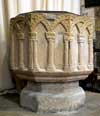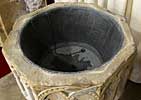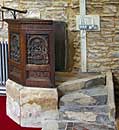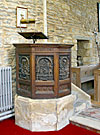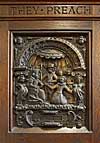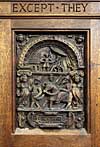Bole St MartinFeatures and Fittings
Font
The massive Norman/Romanesque tub font (35 inches high and 33 inches in diameter) is octagonal with arcades and intersecting arches. It is considered among the more striking examples of a Norman font in a Nottinghamshire church. It may be 12th century, as evidenced by other similar ones in other churches dated to this time.
It is located at the west end of the nave, the correct position, but it would appear that it may have spent some time in the south-west corner of the chancel, judging by the octagonal imprint remaining in the floor there.
The below description is taken (and slightly modified) from that published in the Retford, Gainsborough & Worksop Times on May 20 1881:
‘The font is in three parts, consisting of the base, the shaft and the bowl. The base is octagonal – each side is 11 inches wide by six inches thick. The shaft is also octagonal, three and a half inches thick and nine inches wide on each side. The bowl is also octagonal – each side is 14 inches wide to a depth of 20 inches, where it narrows down to a width of ten inches on each face. Each of the eight principal faces of 20 inches by 14 inches is divided into two compartments by a pillar two-thirds of its height in the centre, from which spring interlacing arches encircling the top part of the font to a depth of seven inches. The whole height of the font is 35 inches, and its diameter 32 inches. The cavity for holding water is circular, 26 inches in diameter, and 14 inches deep. The interlaced arcading around the bowl has round piers, scallop capitals and moulded heads, and is believed to be of earlier date than the base and stem.’
Pulpit
Made of oak, the impressive 19th century pulpit was given in 1866 by the local ecclesiologist Sir C H J Anderson. It is octagonal, with late 16th century Flemish relief panels and Renaissance borders, on an ashlar base. The inscription around the border reads:
| HOW SHALL THEY PREACH EXCEPT THEY BE SENT |
The panels show the story of Esther, Ahasuerus, and Haman, albeit dressed in Elizabethan-style ruffs and tall crowned hats.
The following summary of the story they tell was written by Arthur Mee in 1938:
‘Elaborately carved in relief, with 8 figures and 8 cherubs in ornamental arcading, they tell the story of Esther and Haman in scenes in which 19 vivid figures take part. We see King Ahasuerus sitting under the canopy of his tent, and a man behind him with a halberd. Esther, who kneels before him, is attended by two maidens, and has come to use her influence on behalf of the Jews. We see Haman summoned to advise the king how to deal with a man he wishes to honour, and Haman, thinking the honour is to fall on his own shoulders, suggesting that the royal crown and raiment be put on the man and that he should ride through the streets on the king’s horse. The next scene shows Haman, with drooping countenance, leading the king’s horse, on which rides his enemy Mordecai in the royal apparel. In the last picture the king and Esther are sitting at the banquet with Haman. Ahasuerus is handing a cup to Haman, who now looks mightily pleased at the honour shown him in being the only guest at the feast, little suspecting that soon he is to be hanged on the gallows he has prepared for Mordecai. The gallows is in the background, with Haman’s tiny figure hanging from it.’
Rood and Calvary Group
 The rood is carved and painted, with foliate bosses on bressummer. The rood is carved and painted, with foliate bosses on bressummer.
The calvary group was installed in 1935 and is dedicated to the memory of Elizabeth Julia Glassford, the late wife of the then Reverend D.T. Glassford, as attested by a brass plaque in the south-west corner of the chancel.
Painted Royal Arms
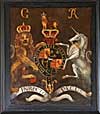 Royal Arms Royal Arms |
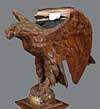 Lectern Lectern |
On the north wall of the chancel is a painting of the Royal Arms dated to c.1707-1714. The arms are those of Queen Anne, but the painting was subsequently partially altered on the accession of George I.
Lectern
Carved timber eagle lectern on a turned stem, dated to 1918.
Piscina
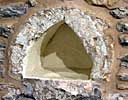 Piscina Piscina |
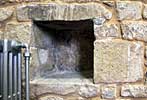 Aumbry Aumbry |
There is a small, pointer-arched piscina in the south wall of the chancel.
Aumbry
A square aumbry is set in the north wall of the chancel.
Sanctuary lamp
 In the chancel, given as a memorial by the children of the Glassford family at Christmas 1937, as attested by a brass plaque in the south wall of the chancel. In the chancel, given as a memorial by the children of the Glassford family at Christmas 1937, as attested by a brass plaque in the south wall of the chancel.
Statues
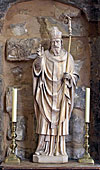 Statue of Statue of
St Martin |
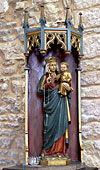 Statue of Statue of
Madonna and Child
|
There is a statue of St Martin in the north-west corner of the nave, and one of the Madonna and Child in the south-west corner of the chancel.
In the 1930s there were a number of fine Arundel prints on the nave walls, which once belonged to Vernon Harcourt, Archbishop of York. These were subsequently removed and kept in the school room. The nave walls now contain small framed drawings of the 14 stations of the cross.
| 




